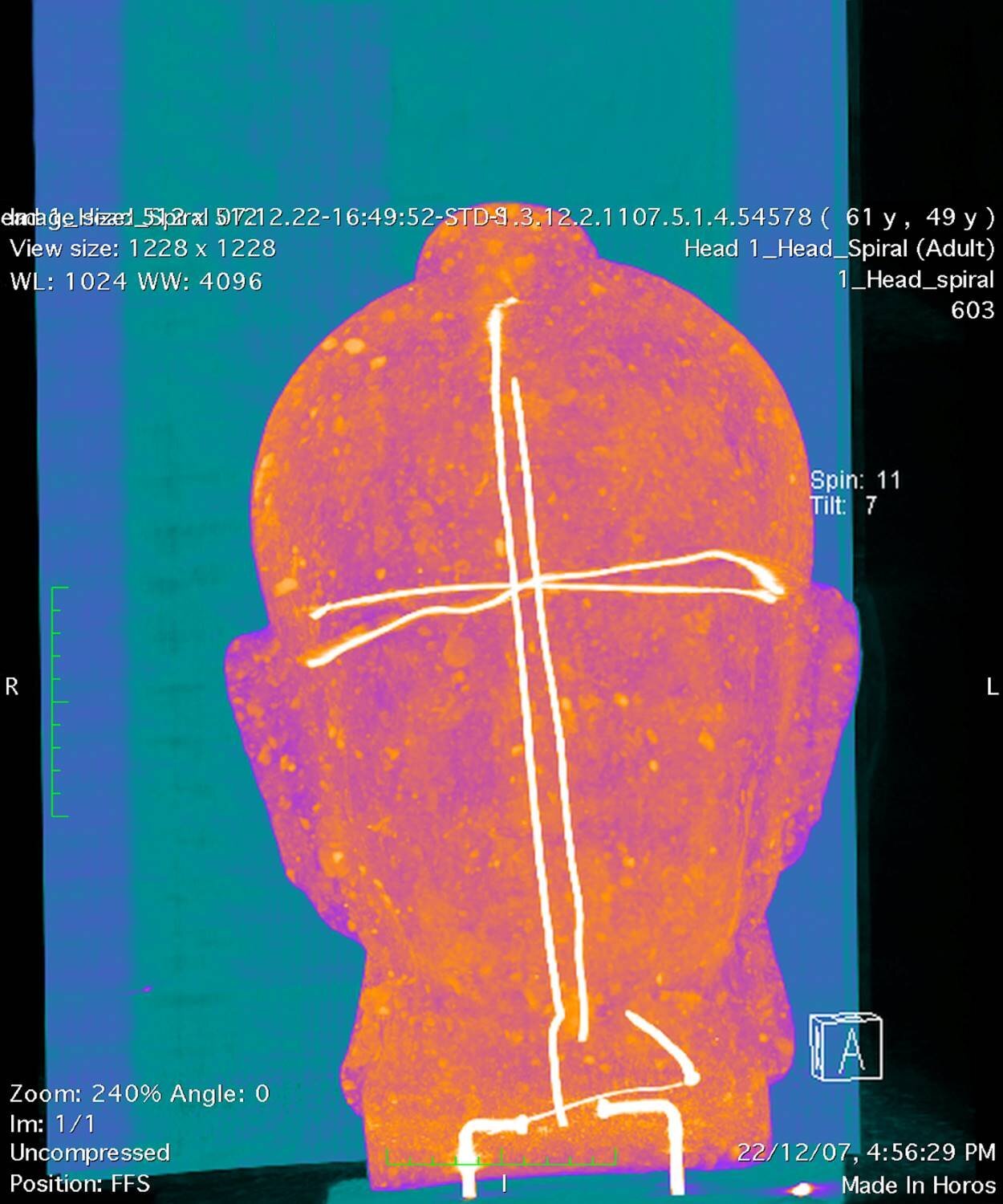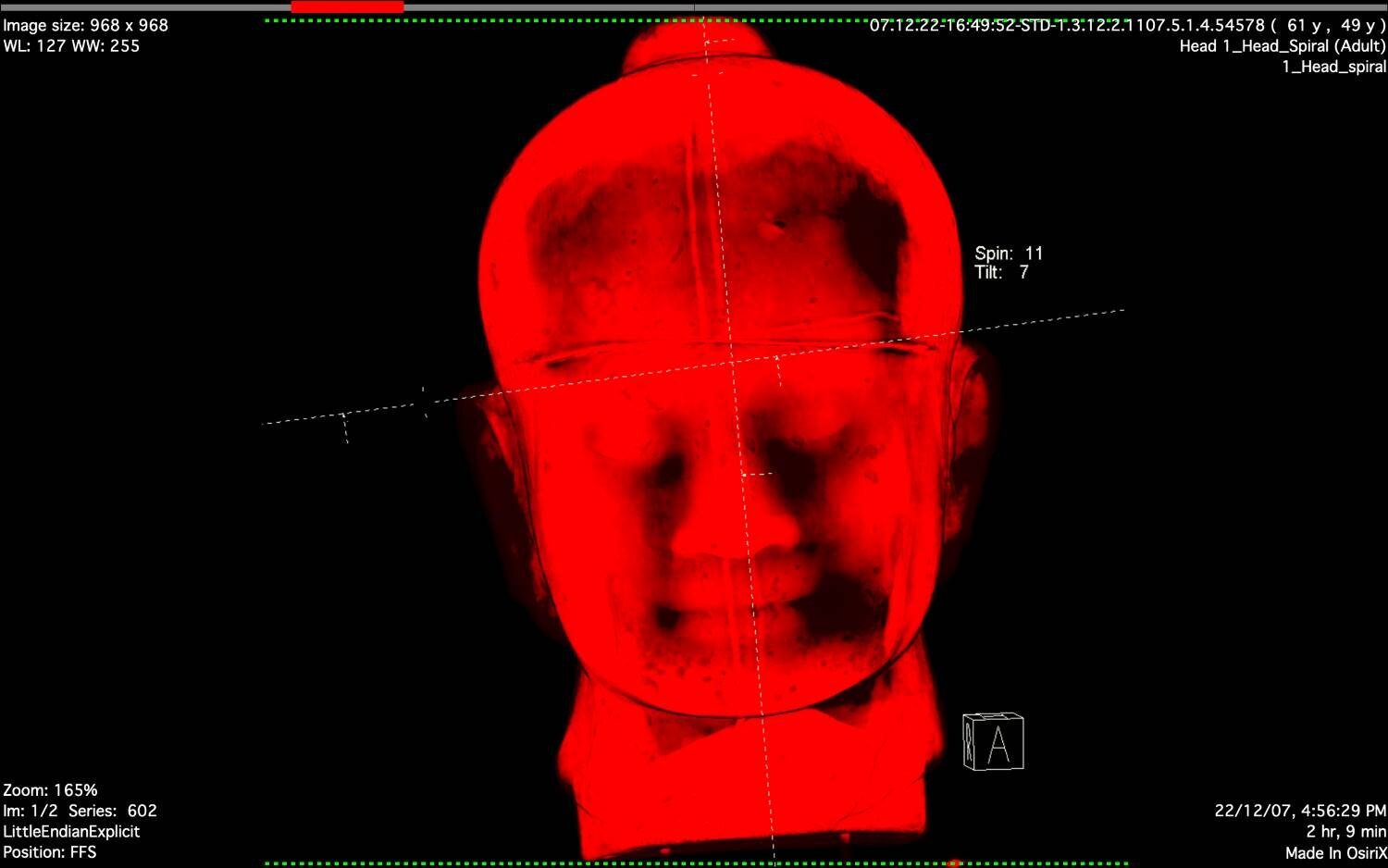Guillaume Levy-Lambert’s ‘Le Secret Sacré’
Divine providence and Khmer King Jayavarman VII
By A&M
Guillaume Levy-Lambert, ‘Croix Pop’, 2019, dye-sublimation print on chromaluxe aluminium, mounted on black acrylic structure, 60 x 50 x 5cm. Image courtesy of Art Porters.
On 10 January, Guillaume Levy-Lambert will present ‘Le Secret Sacré’ at Art Porters. This exhibition is 12 years in the making. In May 2007, friends came to stay with him and bought an unusual gift as a thank you —a sculpture replica of the head of Khmer King Jayavarman VII (1125-1218) from the National Museum of Phnom Penh— to thank Guillaume for his hospitality. This was wrapped in sheets of Cambodian newspapers and held together by translucent brown BOPP (biaxially oriented polypropylene) tape to protect the item.
Guillaume chose to not to open the gift in front of his friends, according to Japanese tradition, and continued to keep it wrapped after they had left. But six months later, his curiosity got the better of him. Instead of opening it up however, he brought it to the hospital. “I felt a bit guilty about being rude to my friends,” says Guillaume. “I carried all 15kg of it to the hospital. I got it scanned. First I saw the head I was expecting to see. For me, it’s the most serene face you’ve ever seen. It was like having my cake and eating it because it is still packed.” This was the beginning of Guillaume’s artistic intervention.
The gift was subjected to a computerised tomography (CT) scan. Used by doctors to see inside a patient’s body, it combines X-ray images taken from different angles around the body. Computer processing is then used to create cross-sectional images of the bones, blood vessels and soft tissues within. The CT scan revealed a cross-like metallic structure used to hold the replica together. Eventually, Guillaume, with the help of a friend, began to visualise it instead as the shape of the letter T of TYNA, a company he had just set up. This was revised from the original name TINA which would have stood for ‘This Is Not Advertising’, an intentional, symbolic departure from the advertising career he had then just left behind. The new acronym stood for the more positive message ‘Treasure Your Natural Abilities’. At about the same time, a friend told Guillaume that in Russian, the word “tyna” stood for sacred secret, or le secret sacré, which related to what TYNA represented for its founder. The crucial ingredients for the current exhibition were slowly but surely coming to be.
A firm believer of cosmic collaborations, Guillaume is motivated by coincidences such as this. He pays attention to how gifts from friends, in their various forms, are connected to each other and in turn, these become the map for his next steps. Savina Apte, the exhibition curator, notes in the catalogue essay that the artist’s “practice is personal and intimate and yet accessible, where experience is permitted to expand beyond instruments, ideas and methodologies” and that “it is psychodramatic and presents and represents ideas – turning them into actions, spaces and moments.”
Guillaume Levy-Lambert, ‘Face D’Ange’, 2019, dye-sublimation print on chromaluxe aluminium, mounted on black acrylic structure, 60 x 50 x 5cm. Image courtesy of Art Porters.
Using medical imaging software, the artist has played with different settings —which doctors use to look for anomalies in scans— to create a series of works . In ‘Croix Pop’, we can make out the silhouette of the head but its features are obscured in a motley blending of pink and orange splotches, against a contrasting blue-green background. In ‘Face d’Ange’, or the face of an angel —a nod to the King’s good work during his reign, including the building of over 100 hospitals— the varying shades of orange in light and shadows reveal the eyes, nose and lips against deep liquid blue surroundings. These are part of a host of 12 unique-edition dye-sublimation prints on white aluminium, each 60cm high and mounted with a five-centimetre wide black acrylic structure that allows each one to stand like a book on its own.
Guillaume Levy-Lambert, ‘Le Repos Rouge’, 2019, archival print on ILFORD smooth rag, 62.5 x 100cm. Image courtesy of Art Porters.
Two other versions portray the face of the King more darkly, and draws attention to his mortality. These are in a group of four unique framed archival prints measuring 100cm wide. ‘Le Repos Rouge’, meaning red rest, show the bone structure of statuette in a stark red, shaded with black that show up the eye sockets, nose bridge and teeth. And in ‘Le Sommeil’, meaning sleep, the figure is in black, with some lightness in the centre, against a tranquil grey. The deft play of colours in these two sets of works, supported by evocative titles, help the audience to make sense of each version of the King, and seen together, we become even more intrigued by the character, which we are seeing literally in different light from one work to the next.
The original X-rays from 12 years ago are presented in ‘This is Not Advertising (Single)’ and ‘This is Not Advertising (Double)’. Mounted on mobile X-ray viewing lightboxes, as one would expect in a doctor’s office, the titles of the works link to the draft form of TYNA, and charts the artist’s development of the prototype into its final colourised iterations.
Guillaume Levy-Lambert, ‘Homage to Christo (part one)’, 2019, cambodian newspaper, scotch tape, mysterious gift, 60 x 35 x 40cm (approximately). Image courtesy of Art Porters.
The readymade that launched all these works has pride of place in the exhibition. It sits floating, still mysteriously shrouded in its original covering of newspaper and tape, inviting everyone to take a closer look and imagine what lies beneath. Guillaume has titled it ‘Homage to Christo (Part One)’. ‘Homage to Christo (Part Two)’ is an original preparatory drawing by French artist Christo and his wife Jeanne-Claude for their 1985 project wrapping Pont Neuf in Paris. This is an artwork that has long intrigued Guillaume. 41,800 square meters of shiny beige woven polyamide fabric were used to cover the bridge, including its twelve arches, the parapets, the sidewalks and curbs and the street lamps. “I think in art, it is always about paying homage to masters. “Christo has his own calendar story, for his wife Jeanne-Claude was born on the same day as he was, so they had a cosmic relationship as well,” says Guillaume. The artist is referring to the genesis of The MaGMA Collection of over 400 works of contemporary art, which he has grown together with his partner Mark Goh. In 1999, he and Mark had visited the Museum of Contemporary Art in Los Angeles a month after they met, where they discovered that Roy Lichtenstien’s ‘Desk Calendar’ (1962) had both his date of birth and Mark’s birthday inscribed on it.
A video, ‘Beau T’, meaning beautiful T, chronicles the journey of the exhibition, in collaboration with Israeli video artist Romy Engel. Engel previously worked with Levy-Lambert on ‘Evidence’, one of 25 short films in The Yud Video Project, which was on display at the Contemporary Jewish Museum between November 2016 and June 2017. This documented Guillaume returning calls that were made to the phone number that was also inscribed on ‘Desk Calendar’. It had previously belonged to Leo Castelli and Guillaume acquired it in 2011.
The video ends with the song ‘Le Secret Sacré’, composed and sung by Dutch singer Devi Reed and performed together with Cam Ryon. “So there’s a song, and this is like another cosmic collaboration,” says Guillaume. “As I was working on the video, I went on YouTube and searched for “sacred secret” in YouTube in English. I listened to the top three things. The first two were not interesting. The third one was in French uploaded on 24 October, just a few days before I was working on this video in November. The singer is Dutch but works in French and I contacted him on Facebook and he gave me the song immediately. For me, it’s divine providence.”
Guillaume Levy-Lambert. Image courtesy of Art Porters.
To add to the multisensorial nature of the exhibition, Guillaume has worked with Carine Certain Boin, a perfumer at the fragrance industry giant Givaudan, to create the perfume Ren'essence, which features Arabian jasmine and osmanthus from China, benzoin gum from Laos, ambregris to represent the temples built by the King and Akigalawood, which is exclusive to the perfume company. It begins with the word 人 or ren, which means human in Chinese. The character viewed upside down looks like the Y in TYNA, just like the T-shaped structure in ‘Homage to Christo (part one)’ looks like the T in TYNA. It is also a play on the word renaissance, a rebirth of sorts for the replica and for the King. “Guillaume has made it a timeless story, with this statue re-revealed by modern technologies,” says Boin. “It is like a new life and new beginning for this King. I worked on the idea of the fragrance also being part of this re-revelation and wanted to craft a fragrance that would bring optimism and light, a bit like a regenerative sunrise.”
The name of the perfume —and the exhibition in its entirety— also represents a rebirth for TYNA. What Guillaume envisioned as a business for over 12 years, as long a gestation period as this exhibition has had, never really took off. “It was only when I accepted that TYNA the registered company would no longer exist six months ago that it re-emerged as an art project and gained traction,” says Guillaume.
“Divine providence” has guided Guillaume’s metamorphosis from art collector to gallerist to artist. His keen eye for detail, and his determination to search for meaning make him adept at drawing connections between discrete events to piece together a coherent, and compelling narrative. The story of ‘Le Secret Sacré’ is a captivating one that encourages us to look for evidence of divine providence in our own lives as well.
‘Le Secret Sacré’ at Art Porters which is supported by BNP Paribas, runs from 10 January 2020 to 15 March 2020 in Gallery Room 2. The exhibition aims to raise funds for the radiology department of the Jayavarman VII Children’s Hospital in Siem Reap. Concurrently, Taiwanese artist Wu Kuan-Te’s solo exhibition ‘Sharing the Moon’ will be presented in Gallery Room 1 from 14 January 2020 to 15 March 2020.












